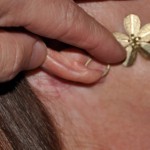
How do these these smaller facelifts manage to remove those jowls and tighten up saggy neck skin with less scar? The reduction in scarring occurs at two specific locations along the temporal and occipital hairlines, allowing no scar to enter either area. What is the relevance of having less scarring around your ears? The avoidance of visible scars is one obvious benefit. But an equally relevant issue is not having hairline displacement which can be just as distracting as that of wide scars. When a facelift incision runs vertically up into temporal hair-bearing skin, skin flap movement will almost always displace the sideburn or preauricular tuft of hair upwards. When the incision behind the ear extends into the occipital hair, an unnatural notch in the hairline may become may be visible in short haircuts or if one wears a pony tail.

While the appeal of less scarring and a smaller procedure is significant, a mini-facelift is not for all jowl and neck aging concerns. As people today are seeking improvements at ever increasing younger ages of age 45 or 50, the size of their jowls and how much their neck skin is sagging is less than those age 60 or older. As a result a younger person needs less of a facelift than those that are older. These procedures help create a smoother jawline, soften deepening nasolabial folds and help restore a curved or more inverted triangular facial shape. In greater amounts of facial aging, a mini-facelift is not as good as improving the significantly droopy neck as that of a traditional facelift. This is why older patients with more advanced neck problems have to accept the trade-off of greater scars from more extensive facelifts.
These mini-facelifts can be combined with other limited procedures for improvement in the rest of the face as well. Such procedures as neck fat removal by liposuction, removal of excess upper eyelid skin and lower eyelid bags and skin refreshening through laser or chemical peels, that tired aging look can be reversed in matter of hours.
Dr. Barry Eppley
Indianapolis, Indiana



